American Sabbatical 102: 4/25/97
Bent's Fort
4/25.. Dodge City.
Out onto the prairie. The world spreads wide. Then wider. And the sky becomes an immense
dramatic canvas. All in grays today. Gigantic ink washes.
Last April we flew from Dalles-Ft. Worth to Denver on our way
to visit Seth, and the sere emptiness below us had seemed the
ultimate desolation. Only relieved by irrigated crop circles of
green, and the fan branching of watercourses. Driving across the
Dakotas last fall we had been entranced by the grasslands in their
myriad shades of beige, and moved by the subtleties of small details
against a landscape fit for Hudson School canvases. Now we were
back in it, staggered by the scale, and by our exhaustion. We’ve
been on the road too long, and this bit is the longest road of
all.
Plains of passage. That’s how most of us think of what they called
the Great American Desert. We leave high contrails over it, or
jack in the books-on-tape and set the cruise control. Even the
history is all about crossing over. Zebulon Pike fumbling his
way up the Arkansas. Washington Irving making a Boswell’s tour
through Oklahoma. Custer making forced marches over the Cimarron
in the late 1860s. Chisolm and Goodnight driving longhorns to
Kansas railheads. Now the big rigs tunneling through the air with
their airfoil cowlings, and the long Santa-Fe freights strung
out behind four locomotives.
Young wheat and mature cover crops make green patterns in the
sea of bleached umber. The big irrigators are idle today, letting
heaven do the work. We run in and out of gentle rain falling from
slate stratus. The idle sprinklers are self-propelled pipelines
raised a dozen feet in the air on triangulated pylons with fat
tires. Close inspection shows bulky electric motors driving the
4-wheel drive units, spaced implausible distances along the segmented
waterworks. The whole rig looks like it would fall over the minute
it started marching around its circuit. And what if motor #15
started to run at the speed of #32?
We are still plotting our course by the two-lanes, as much as
we can. Out here even the tertiaries are full-throttle, though,
the cattle wagons and pipe trucks pushing 70, with no shoulders
to let them by. We’re holding the Owl at the edge of traction,
cab-overs with devil-horn stacks snorting at our backs.
Hennesey, Lacey, OKeene, Seiling, Woodward. Crossroads towns half
dried and blown away, or full of farm trucks and mud-streaked
commerce. Each burg with its claim to fame. State Track Champions.
Local restaurant called The Locker-room. Not too appetizing. We
roll on. Settle for The Dog House, honoring a high school team
called the Bulldogs. Kind of the way we feel.
The Owlers are definitely out of salad country again. No roadside
stands in this season, if any. Even the fruits and veggies in
the markets are as jaded as in Newfoundland. There’s no sign of
home gardens, either. Hard to believe that farmers aren’t interested
in eating well. Too busy plowing to the roadside, I guess. We’re
reduced to breakfasts as the only sure restaurant meal.. and no
more grits. Our chow at the Dog House was a couple of Denver omelettes
(cheese and bell pepper and onion) presented with simple attractiveness.
A family operation. Grandma got up from her meal in an adjoining
booth to get hot water for my tea. Cashing out, Peggy gushed about
our journeys, but didn’t raise a look of longing or interest.
The fresh-faced couple behind the counter were almost as flat
of affect as the horizons around them. Maybe you have to be to
stay in the Dog House.
Even our glazed eyes couldn’t help observing the changing parade
of vegetation. There’s more diversity in the thickets and watercourses,
and in the fallow fields, than you’d imagine. A wildness still
lurking on the edges of the breadbasket. Twisted and spiny trees,
tenacious shrubs, unfamiliar grasses and woody growths. Even at
the end of winter, when the cottonwoods all look dead, shedding
their bark and limbs, the persistent variety of the green urge
impresses us.
Fly as we might, we couldn’t bypass all the historic possibilities.
There was Dodge City looming up ahead of us. End of the cattle
trail. Wyatt Earp and all that. We followed signs for Front Street
and Boot Hill. But the Wild West Show was a stageset row of bright-painted
false fronts with hokey TV nostalgia. We peeped though the fence
and chose not to finance this Mom and Pop. Circled round through
today’s Dodge, of dingy brick businesses on the slope of that
famous hill, and towering grain elevators along the historic tracks.
That was when we saw the signs pointing up Boot Hill: The Teachers’
Hall of Fame.
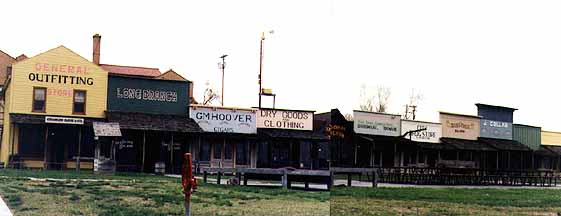
Dodge City
(Memo #100)
Apr 25 Kansas Teacher Hall of Fame
Who? Kansas Teachers honored each year
What? Hall of Fame
When? begun in 1977
Where? Dodge City, Kansas
How? supported by state and teachers
Topics: history of education, teacher roles and conditions
Questions: What qualities are most revered in teachers? How has
education and the work of teachers changed? |
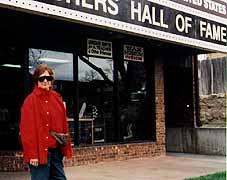
|
We went to Dodge City, Kansas, to see the wild frontier town of
shoot outs and saloons and found, instead, the Kansas Teacher
Hall of Fame. Dodge City DOES have a reconstructed main street
of false front saloons and stores that is a tourist attraction
and has a hefty entrance fee. We drove around town and it is a
tree filled county seat with some bricks paved streets. The downtown
seem pretty alive and there is the expected strip of fastfooderies
and malls (and western wear shops) along the major routes in.
The Kansas Teacher Hall of Fame, the first such memorial in the
nation, is on Boot Hill (named for the idea that a true cowboy
dies with his boots on). Started in 1977, it is housed in a former
business building which it shares with the Wax Museum. The sidewalk
outside has bricks listing the businesses and groups that have
supported the Hall of Fame and honoring particular teachers.
Each year the eleven educational districts of Kansas elect a Teacher
of the Year. The eleven have photographs and write-ups which are
displayed in a group in the Hall of Fame. The first four years’
winners are also on the walls, then there are hanging files for
all the other years. A separate small room has displays of photographs
of the presidents of the Kansas Teachers Association. A large
back room has a display of historic teaching materials (games
and books and teacher’s certificates) and photographs, and there
is an old fashioned classroom set up (with an inkwell on every
desk). They have reproduced two hilarious lists of rules for teachers
from the past.
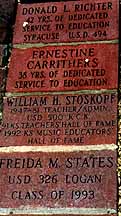
|
The 1872 rules include the following:
1. Teachers each day will fill lamps, clean chimneys
2. Each teacher will bring a bucket of water and a scuttle of
coal for the day’s session...
4. Men teachers may take one evening each week for courting purposes,
or two evenings a week if they go to church regularly...
8. Any teacher who smokes, uses liquor in any form, frequents
pool or public halls or gets shaved in a barber shop will give
good reason to suspect his worth, intention, integrity and honesty. |
These would more funny if I didn't' t remember being told “never
to let a townsperson see me with liquor or beer in my hand” when
I started teaching in another area of Maine seventeen years ago!
I’m sure other older teachers can tell of equally interesting
rules and conditions they have worked under. Much has changed
in education. It’s nice to see teachers so honored. There were
several foreign teachers visiting, from Australia and New Zealand.
One man from Indian spent several hours at the center, marveling
at the respect paid to teachers. There is also a gift shop with
a variety of things shaped like apples and schoolhouses. Kansas
also is home to the National Teacher Hall of Fame.
4/25.. cont.
Dodge City maintains some traditions. Threadbare cowboys, cash heavy in this settle-up town, would
suit up in new duds and wash down a long thirst. We didn’t hit
the saloons, but we did check out the haberdasheries.. or at least
one. The saleswomen were offering sparkling outfits in both Spanish
and English to a mixed audience. Chaps and tack, leather-trimmed
wool vests, fleece-lined range coats and ten-gallon hats, fancy
shirts. I bought one to improve my attitude. Peggy was dubious.
The other honored tradition here is beef. Dodge is still the railhead
for the burger train. And smells like it. Feedlots blacken the
landscape and flavor your breathing. Abbatoirs and freezer plants
line the highway. Reeking animal trailers plume their unpleasantness
into town and reefers labeled SWIFT fan out in all directions.
We follow one west, promising to keep our pledge about beef.
The rain and the miles catch up with us at Garden City, a hopeful
sounding metropolis. We laugh as we pass The Garden Bowl, a ten-pin
establishment. There’s a certain air about this burg. Phew. Don’t
it stink? Everything is widely spaced here, and we discovered
why. Half the businesses are feedlots. At least it smells that
way. The chain motel we were aiming for was actually next door
to one. Even upwind the stench was intense. Peggy came out with
a great big grin on. Full up. So sad. We were directed to a local
spa.. with a hot tub and A HEATED POOL. Peggybliss. It wasn’t
even in sniffing distance of an abbatoir. Turns out there’s an
agricultural equipment fair on in Stillwater. And I’d forgotten
to bring my overalls. Dang.
4/26.. Bent’s Fort.
Saturday awoke raw and damp again, but patches of blue kept trying to open up on the clouded horizons.
This was to be our last day of the long slog to Boulder. Let it
rain.
In the end it didn’t, but the uncertain winds flung tumbleweeds
across the Owlpath and brought us rank warnings of passing beef
factories. Occasional low bluffs relieved the pitiless horizontality,
and the cutbanks of the meandering creeks looked like undressed
wounds. Precious little water even in the bridged streams, just
sandy flats with thirsty cottonwoods casting shadows in serpentine
lines. I spotted my first cactus, some kind of convoluted chollas.
We followed the Arkansas into Colorado, with a hoot of glee, and
pointed our fading historical ambition toward one last storied
spot, this lap: Bent’s Fort.

The Fort
The National Parks Service did us proud at Bent’s Fort. We stepped
out of time again. Even the searching wind curling over the battlements
and around the adobe quarters had a timeless keening. The sun
decided to come out to play among rising cumulus, and the interior
yard of the fort was bright yellow, but the north wind had the
edge. I shivered through a watercolor while Peggy made the guides
feel good.
(Memo #101)
Apr 26 Bent’s Fort
Who? brothers William and Charles Bent and partner Ceran St. Vrain
What? Fort on Santa Fe Trail
When? 1833-1849
Where? on the Arkansas River in southeastern Colorado
How? experience trading with Indians + blazing new trail
Topics: Santa Fe Trail, the Fur Trade, fur traders, the Bent Brothers,
business practices on the frontier.
Questions: Why was the Santa Fe Trail important? How and why did
the Bents build their fort? What was its history? |
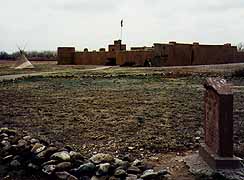
Bent's Fort
|
We have learned never to predict what sites will be great. I was
disappointed with the Cherokee sites in eastern Oklahoma that
I had so anticipated. On our last day of driving to Boulder, Bryce
suggested we take the route via Bent’s Fort in southeastern Colorado.
I’m SO glad we did. Just when we thought we were thoroughly toured
out and most sites were hokey, we came upon this gem (and stayed
for hours).
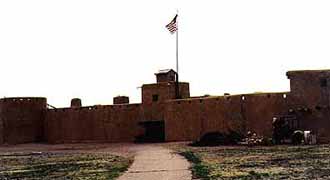
Closer
|
Bent’s Fort was the most important terminus on the Santa Fe Trail.
It’s located at the point where the trail turns south, away from
the Arkansas River. We followed the Santa Fe Trail along the Arkansas
River for several hours west from Dodge City, Kansas, into Colorado.
It is dry high desert, the palette is pale beige and brown and
gray with tumbleweed and yucca and clumps of grass, small shrubs
and trees along the river. The river itself (which varies from
100 to a 1000 feet wide during the year) is shallow and broad
along a sandy course without clear banks.
|
From the time of Cortez to the early 1800’s, the northern part
of the Spanish Empire was served by El Camino Real (the royal
road) north from Mexico City. Distant provincial towns like Santa
Fe got few trade goods. In 1821 Mexico became independent and
opened its trade to Americans. William Becknell made several round
trips to Santa Fe from St. Louis blazing a new trail, and realized
an 800% profit on his trade goods. Even with huge taxes charged
by the Mexican government, the profits on the Santa Fe Trail were
huge. Charles Bent from St. Louis made an early trip after buying
goods on credit.
His brother William Bent lived in the west as a trapper, and followed
the Plains tribes. This was the era of the mountain men who spent
long months in the Rockies trapping beaver and then brought the
pelts east . William became a trusted trader (“Little White Man”),
bringing firesteel / flint / axes / textiles / iron kettles to
the Cheyenne and Comanche and Arapaho (while Charles and a close
friend Ceran St. Vrain took canned goods / textiles / tobacco
to Santa Fe). William saved the lives of several Cheyenne and
married a Cheyenne named Owl Woman.
|
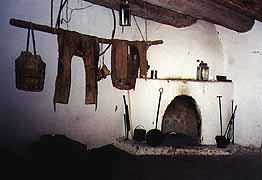
Accomodation
|
The three men (William and Charles Bent and Ceran St. Vrain) decided
to build a stockade in the west. In 1833 They built “Fort William”
with Mexican laborers. For the next 16 years “Bent’s castle” dominated
trade on the Trail. It was 50 days travel west of Independence,
Missouri. Mexico began across the river. Our guides point out
that it linked three worlds - Mexican, American, Native American.
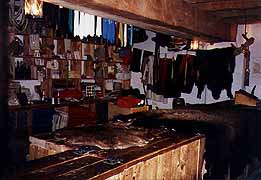
Store Goods
|
Our road followed the north bank of the Arkansas, visible as a
thick strip of small trees. We drove in to a small information
building and parked. A wide path took us over a rise and across
a long open stretch to the fort. It is breathtaking - a long low
adobe structure perhaps two hundred feet square with the woods
along the river behind it. By the main gate there are several
tepees . You enter through the main gates and find yourself in
a huge open plaza. Rooms open all the way around and several staircases
lead up the rooms on the second level, the battlements, the roof.
There is a corral and stable on the western end. The fort transported
me into an earlier time. We were far away from houses and cars.
There was no modern noise. |
The fort was 60% excavated and was reconstructed on the original
site with the help of detailed drawings made by contemporary visitors
(one an engineer). The furnishings and costumes of the guides
are as accurate as possible, one guide who is in charge of the
costumes had just been on a research trip. The items in the store
are the same as the trade goods the Bents sold - one type of blanket
is still made by the same company!
| Many of the rooms have fireplaces. On the lower level I toured
the Council Room, trade room, dining room, cook’s room (a slave
woman named Charlotte Green), kitchen, blacksmith and carpenter
quarters, the warehouses, the laborer’s quarters. Upstairs were
more living quarters and a billiards room with small bar. Several
small cannons were mounted on the battlements. Each room has appropriate
furnishings and seems to have just been vacated, food is under
preparation in the kitchen for instance. The company storerooms
have boxes and bales of trade goods with authentic company labels.
The trade room and blacksmith‘s room both have the Fort’s record
journals for tourists to thumb through. There are cattle, chickens
and peacocks in the corral. |
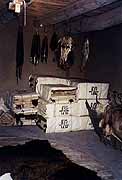
Trade Goods
|
There were always 40-60 people at the fort with many visitors.
When the beaver in the Rockies gave out, the trade centered on
buffalo and 15,000 hides were shipped out each year over the Trail
to St. Louis. A buffalo hide cost 25 cents in trade, and sold
for $6 in St. Louis. They also took bear and mountain lion hides.
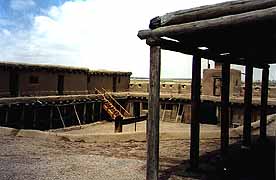
Inside the Fort
|
In the 1840’s conditions changed. The U.S.military became a greater
presence at the Fort as we moved toward war with Mexico. A cholera
epidemic killed half of the Comanche tribe. The buffalo herds
were disappearing. Local resources such as wood were depleted.
Charles Bent started a branch of the business in Taos and was
killed in a local revolt there. William tried to sell the fort
to the government but it wouldn’t pay his price and the fort was
abandoned and burned. There is some controversy over who burned
it. One theory is that William burned it, sensing that it would
be used as an Army post for war against the tribes he knew so
well. |
4/26.. cont.
It was hard to put our backs to this enchanting recreation. From the moment we’d crested a
rise and seen its mud walls shining, we’d lost track of our weariness,
and the time. Still, we had five more hours to Boulder, at least,
and the day was declining.
We were tempted to keep westing until we rose Pike Peak up out
of the flats, but Peggy remembered the highway through Colorado
Springs as deadly, and the prophets were still reporting snow
in the mountains. So we aimed our lubbers-line north, across the
tilted high plains of eastern Colorado. The border signs say:
WELCOME TO COLORADO -- MOUNTAINS AND MUCH MORE. This is the much
more. Same old same old. Cattle carriers and oil pumps. Old straw
and young green. Sometimes a field full of big rolls of springcut
forage. Winter crops?
We intended an end run on Denver, despite its boomtown historic
sites. After all this empty, Boulder would be intense enough for
us. Crossing the interstate just east of the metropolis, we stopped
for supper in a diner in Strasburg. No weinerschnitzel, but superb
enchiladas and burritos. It was obviously an exurb kind of place.
The kids helping mom were pierced and tooed, and talking uptown.
At the same time a small town drama was being performed. It was
prom night, and young things in ball gowns and braces, tux and
gawk, were coming in for snapshots and approval from the lady
of the house, obviously a local institution. She was graciously
harried about getting food to us, but we just smiled and enjoyed
the show. As did our fellow diners, grandparents mostly.
Last leg. And a dog’s at that. Once we were above the latitude
of Denver we turned into the sunset and went hunting for mountains.
The fields were greening up from adiabatic precip. Cloudbanks
walled the horizon, promising heights. First we saw the caravansarie
that is the new Denver Airport, to our south. A cluster of mountain-peak
tents like some mirage in a flat plain. Then, after repeated false
alarms, we rolled up over a rise and snow-covered precipices,
pine-dotted verticals, the whole chin-lifting array opened our
mouths. O.
Boulder was full of snow. And youth. And energy. We tottered into
Seth’s neighborhood, and the kids and the dogs danced around us,
then dragged us in for spinach lasagna and a week’s R&R. Happy
landing.









